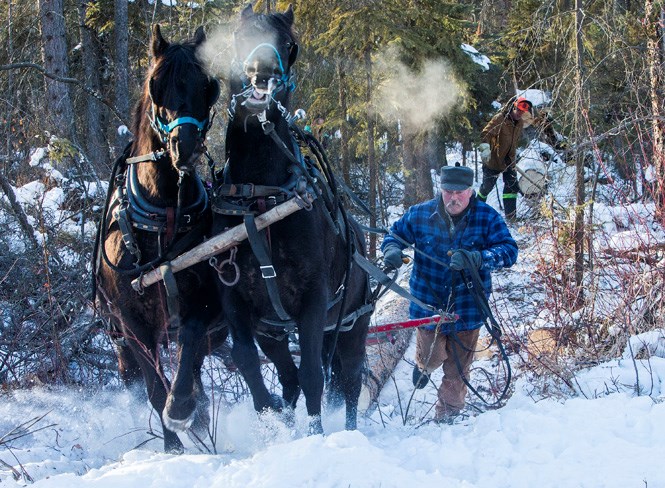White spruce blow-down
Chainsaws and horses will be at work in the white spruce forest this month as foresters look to clean up a mass of wind-felled trees.Contractors with Drayton Valley’s All K Ventures rigged their horses and revved up their chainsaws this week to start hauling about 50 large trees out of Grey Nuns White Spruce Park.
These trees blew down during high winds last summer and were up to 150 years old, said retired forestry professor Peter Murphy, a member of the White Spruce Park working group. While a few broke off at the base, most got ripped out of the ground roots and all.
“There are these huge root pads that stick up eight to ten feet in the air and they’re hazardous,” he said.
While you’d normally want to leave some fallen trees for wildlife such as woodpeckers, Murphy said the sheer volume of dead wood here was a fire hazard. The dead trees also make it tough to walk in and reforest the area, and could cause an outbreak of spruce bark beetles come spring.
The plan is to have the two contractors chop the trees into nine-foot logs and haul them out using horses, which will have less impact on the forest than vehicles, said city arbourist Kevin Veenstra. Parts of the forest will be closed off for safety while this happens.
Murphy and Veenstra said the logs would be stored in an open area near the forest until the city figures out what to do with them. Some of the trees would also be sectioned and preserved for study.
“I think a lot of it can be cut up for firewood,” Murphy said, but some might be good enough to use as lumber.
Murphy said the contractors would likely be at work for about a week.
Questions on the tree removal should go to Erin Pickard at 780-459-1755 ext. 3030.
Degrees make a difference
Much of North America will be three to five times more likely to see record-breaking heat in years ahead if the world warms by three degrees instead of two, a new analysis suggests.Renowned Stanford University climate researcher Noah Diffenbaugh co-authored a study Wednesday that looked at how greenhouse gas reduction targets under the United Nations Paris Agreement would affect the world’s extreme weather. Diffenbaugh has previously served as a lead author with the Intergovernmental Panel on Climate Change and studies extreme weather and climate change.
World governments (except for the U.S.) have committed under the Paris Agreement to keeping global warming to less than 2 C above pre-industrial levels, with an aspirational goal of keeping it to 1.5 C. The world is set to miss that 2 C goal by about a degree under its current emission reduction targets.
Diffenbaugh and his team used historic climate data and models to see how the risk of record-setting heat, cold, wetness, and dryness would change globally based on 1.5 to 2 C and 2 to 3 C of warming – the latter being what the world will get if nations meet their current emissions goals.
“We’re already seeing increases in occurrences of unprecedented extremes from the global warming that has already happened,” he said (which is about 1 C worth) noting that his team previously showed that climate change had increased the odds of heat records in about 80 per cent of the world.
The team found that about half of Europe and more than a quarter of East Asia would be five times more likely than they are today to experience record-breaking warm nights with 2 to 3 C of warming. About 35 per cent of North America would more than triple its risk of record-breaking wet days as well.
Diffenbaugh said his team found that the world could substantially reduce the risk of extreme weather by limiting warming to 2 C. With 3 C, most of North America sees a three to five times increase in its odds of seeing record-breaking heat, for example. Hold warming to 2 C, and you still see more risk, but for the most part not the three-to-five times levels of risk.
“There is a quantifiable reduction in risk from achieving those more stringent targets,” he said.
The study can be found at http://advances.sciencemag.org.



